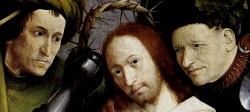
Schmidt 1960
“Das Stachelhalsband des Hirtenhundes” (Leopold Schmidt) 1960
[in: Deutsches Jahrbuch für Volkskunde, vol. VI (1960), pp. 154-181]
[Also mentioned in Gibson 1983: 77 (E29)]
Schmidt demonstrates that the spiked collar, as worn by one of the tormentors on Bosch’s Crowning with Thorns (London, National Gallery) was widespread in late-medieval Europe. Schmidt adduces iconographical sources from the thirteenth up to the early seventeenth century (especially from the fifteenth and early sixteenth century) proving that the spiked collar was worn by sheepdogs. Late-medieval written sources (fourteenth and sixteenth century) teach us that the sheepdogs wore these spiked collars to protect their throat from biting wolves.
Schmidt interprets Bosch’s tormentor metaphorically as a ‘sheepdog whose task it is to prevent the sheep from running away’. He is a strict watch dog: Das ‘agnus Dei’, das Gotteslam, kann diesem Hirtenhund nicht entkommen. Das scheint hier gemeint zu sein (the ‘agnus Dei’, the lamb of God, cannot escape this sheepdog. That is what seems to be meant here) [155].
This article is somewhat superficial in certain respects. For example: Schmidt has not noticed that Bosch also painted a spiked collar on the closed wings of the Haywain triptych and on the Rotterdam Pedlar tondo. When he writes on page 166: Die mittelalterlichen Bildzeugnisse kennen den Hund mit dem Stachelhalsband nur als Hüter der Schafe (the medieval iconographical sources only know the dog with spiked collar as a protector of sheep) this is manifestly wrong. A few times Schmidt himself mentions that the spiked collar was also used for hunting dogs in Antiquity and in more recent centuries (Antiquity: 165-166, more recent centuries: 180-181), but he does not go more deeply into this. Erroneously medieval depictions of hunting dogs with a spiked collar are not mentioned by him.
Interesting, though, is the following: in 1958 the Archiv der österreichischen Volkskunde held an inquiry in order to find out whether the spiked collar was still known in Austria in those days. A source from Heinrichsreith, Post Drosendorf signalled: Nach Mitteilungen der ältesten Einwohner würden diese Halsbänder von den Haushunden getragen, und zwar zum Schutz gegen andere Haushunde, besonders bei Raufereien der Hunde untereinander (according to the oldest inhabitants these collars were worn by domesticated dogs to protect them from other domesticated dogs, especially in the case of scrimmages of the dogs amongst each other) [171].
[explicit 13th August 2012]